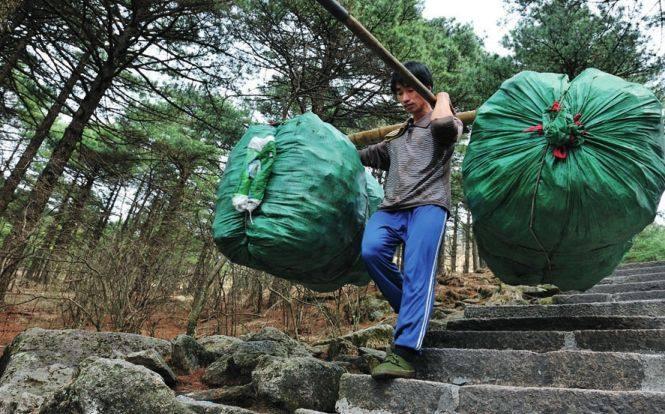Low-Carbon Holidays on Huangshan
By staff reporter FU ZHIBIN
Cleaners in Paradise
Although the mountain path is generally packed with visitors, you would be lucky to spot so much as a tissue along this well-trodden track. The uniformed cable workers, carriers and cleaners that make up the local environmental protection team, however, do come into view from time to time.
Certain cleaners are distinguishable by the long tongs and broom they carry in one hand and reusable bag in the other as they patrol their assigned stretch, picking up litter. Others are equipped with telescopic cant hooks, climbing cams and ropes to remove any garbage out of arms reach. At peak travel season these cleaners are at work from 7 am till sunset.
Carriers are a common sight on Huangshan. All daily necessities, including cleaned vegetables – even building materials – have to be bodily carried to the summit, and garbage and items to be washed carried down. This daily transportation of goods controls the volume of water supply and discharge and minimizes garbage on the mountain. We frequently heard the request, “please let me pass” from carriers along the path laden with 50 or more kg of goods. As those at the front are often the first of a team, they need to maintain a constant pace. When in need of a rest they simply lean on their sticks and catch their breath before carrying on. As the Huangshan management committee confirmed, these carriers have borne on their shoulders every tile and brick used to build hotels on the mountain, as well as the stones to construct the bridges there.
Care and Conservation
Huangshan is famous for its pines, 54 of which appear on the UNESCO Heritage list, and three to five workers are responsible for each one. A team of 19 is assigned to protect Huangshans most famous, 1,300-year-old Guest-Welcoming Pine from insect pests and effects of sudden changes in the weather, and record the state of its trunk, bark and needles. Local and international experts carry out yearly checks on these pine trees to ensure their healthy growth. To avoid afferent insect pests there is a ban on bringing any wood to the Huangshan scenic site. Fifty checkpoints are in operation for this purpose. To guard against forest fires, fire fighters are posted every 200 to 300 meters in the area, and a total 200 are on hand in the event fire should break out.
One of the oldest of the nine wellknown pine tree species in the Beihai zone began to wither in 1972 and eventually died in 1982. Well-known for the resemblance it bore to a dragon standing on the mountain peak, a plastic replica was made of it, and in 2004 a similar pine tree was planted on a 40-meter-tall stone pillar.
Staggered breaks from visitors are an innovative measure specifically aimed at protecting Huangshans natural and cultural heritage. As the mountains broad scope of scenic delights draw huge numbers of visitors, since 1987 accessibility to certain peaks in the Huangshan scenic area has been rotated every three to six years.
Some Huangshan locales are now amid their third break, during which natural recovery combined with human assistance renews damaged woods and vegetation and improves the eco system.
In the 20 years since introduction of the break system Huangshans scenic spots have retained their best possible state, as naturally luxuriant as ever, despite soaring numbers of visitors.
Development and Protection
The well-designed, scientific system of travel resource management and protection of Huangshans natural and cultural heritage have made it a star attraction both in China and internationally. In 1999, China became the first Asian country to be awarded the UNESCO Melina Mercouri International Prize for the management and protection of Huangshan.
Huangshans stunning geographical features and natural environment led to the UNWTO (UN World Tourism Organization) and UNESCOs setting up in March 2008 of the one and only sustainable Tourism Observatory in the Huangshan scenic zone. UN staff use the observatorys world standard equipment to gather, analyze and monitor environmental protection data and samples for global purposes.
At the end of 2011, the Huangshan scenic zone, Asias sole representative, was among the first designated batch of pilot world sustainable travel destinations. The zones management concepts appeared in the Global Sustainable Tourism Criteria for Destinations. In June 2012, assessment expert on the Global Sustainable Tourism Committee Brian Mullis carried out a 10-day observation of Huangshan. He remarked in his findings that, after 22 years of observing sustainable tourism in 45 countries, he is confident that Huangshan could serve as a template for similar destinations. Mullis was impressed with Huangshans prospect planning and lawmaking as well as its well-rounded monitoring, volunteer service, eco protection, lowcarbon travel mode and international cooperation.
Huangshan is a treasure that the Chinese share with people the world over. Building harmonious relations between man and nature has been and remains the focus of protecting and inheriting this precious tract.

